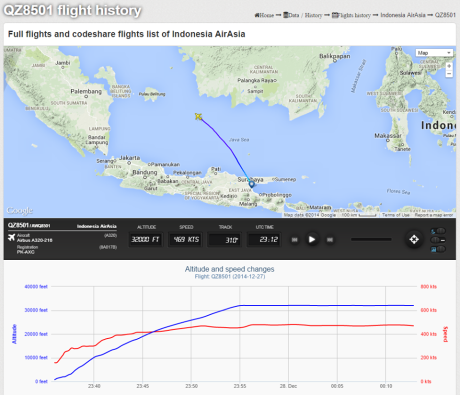
AirAsia A320 gone missing in southeast Asia
On Dec. 28, an Airbus A320-200, registration number PK-AXC, flying as AirAsia Indonesia flight QZ8501 from Juanda International Airport, Surabaya, to Changi Airport, Singapore, lost contact with Air Traffic Control at 06:24 LT over Java Sea.
155 passengers were on board the aircraft: 137 adults, including 2 pilots and 4 cabin crew and 1 engineer, 17 children and 1 infant.
The aircraft was piloted by a captain with an experience of 20,537 flying hours, 6,100 of which were with AirAsia Indonesia on the Airbus A320. The first officer had a total of 2,275 flying hours with AirAsia Indonesia.
According to Indonesia’s Transport Ministry, while flying at FL320 (32,000 feet), QZ8501 requested to deviate and climb to FL380 to avoid very bad weather in the area. Clearance to climb could not immediately be granted because of nearby air traffic.
The Ministry said the aircraft could be tracked by ADS-B until 06:18, when it went missing from radars. Flight crew did not radio any mayday or emergency message.
Noteworthy, a leaked ATC image published by Gerry Soejatman on Twitter shows the AirAsia flight climbing through 36300ft with a Ground Speed of only 353 knots: provided the image is genuine, the radar screenshot would show an airplane much slower than expected at that altitude (a nearby Emirates flight at FL360 – 36,000 feet – was flying at 503 knots).
Image credit: via G Soejatman (highlights mine)
Flightradar24 receivers have tracked the flight by means of ADS-B until 06:12, when the aircraft was at FL320, 469 knots, 310° heading.
Although any attempt to explain the reason for the disappearance of the AirAsia flight is pure speculation at this time, we can’t but notice at least one apparent similarity with another famous crash: Air France 447.
AF447 was an Airbus 330 from Rio de Janeiro to Paris that plummeted 38,000 feet in 3 minutes and 30 seconds and crashed into the Atlantic Ocean in 2009. In that case, pilots responded to a stall, induced by inconsistencies between the airspeed measurements likely due to pitot tubes being obstructed by ice, by pulling the nose up instead of pushing it down to attempt a recover.
Even though a low Ground Speed can be caused by strong head winds, the fact that nearby Emirates was cruising at 36,000 feet at a speed of 503 knots, seems to suggest that the missing Airbus 320 was probably too slow and closer to the stall speed than it should have been.
Anyway, although no sign of wreckage, oil, debris were found so far, experts believe there are more chances to locate the aircraft than the Malaysia Airlines MH370 which vanished in March this year and has not be found yet.
Image credit: Flightradar24.com
Related articles
-
 Air India Boeing 787 Dreamliner loses radio contact gets intercepted by Italian Typhoons
Air India Boeing 787 Dreamliner loses radio contact gets intercepted by Italian Typhoons -
 “U.S. spyplane violated Swedish airspace to escape interception by Russian jets”
“U.S. spyplane violated Swedish airspace to escape interception by Russian jets” -
 What we know and what we don’t about the mysterious Malaysia Airlines MH370 disappearance
What we know and what we don’t about the mysterious Malaysia Airlines MH370 disappearance -
 Hijacked Malaysian Airlines Boeing 777 shadowed other airliners to escape detection?
Hijacked Malaysian Airlines Boeing 777 shadowed other airliners to escape detection? -
 Airliner and Russian spyplane nearly collide off Sweden
Airliner and Russian spyplane nearly collide off Sweden -
 Following bomb threat two Italian Typhoon jets perform supersonic scramble to escort Lebanese Airbus 320
Following bomb threat two Italian Typhoon jets perform supersonic scramble to escort Lebanese Airbus 320 -
 All you need to know about last week’s B-2 stealth bombers round trip mission across the Atlantic
All you need to know about last week’s B-2 stealth bombers round trip mission across the Atlantic









No comments:
Post a Comment